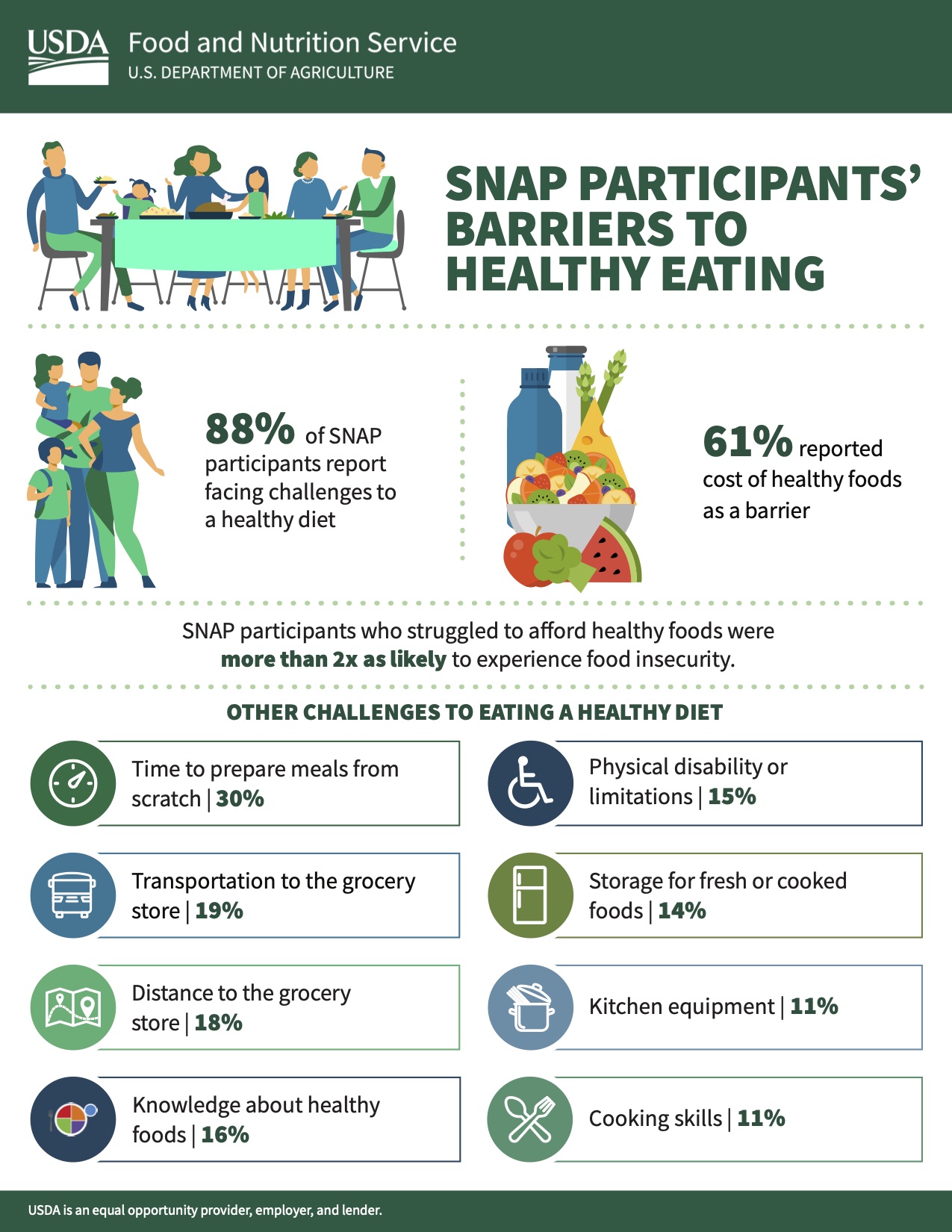Barriers to Healthy Eating by SNAP Participants
go.ncsu.edu/readext?805749
en Español / em Português
El inglés es el idioma de control de esta página. En la medida en que haya algún conflicto entre la traducción al inglés y la traducción, el inglés prevalece.
Al hacer clic en el enlace de traducción se activa un servicio de traducción gratuito para convertir la página al español. Al igual que con cualquier traducción por Internet, la conversión no es sensible al contexto y puede que no traduzca el texto en su significado original. NC State Extension no garantiza la exactitud del texto traducido. Por favor, tenga en cuenta que algunas aplicaciones y/o servicios pueden no funcionar como se espera cuando se traducen.
Português
Inglês é o idioma de controle desta página. Na medida que haja algum conflito entre o texto original em Inglês e a tradução, o Inglês prevalece.
Ao clicar no link de tradução, um serviço gratuito de tradução será ativado para converter a página para o Português. Como em qualquer tradução pela internet, a conversão não é sensivel ao contexto e pode não ocorrer a tradução para o significado orginal. O serviço de Extensão da Carolina do Norte (NC State Extension) não garante a exatidão do texto traduzido. Por favor, observe que algumas funções ou serviços podem não funcionar como esperado após a tradução.
English
English is the controlling language of this page. To the extent there is any conflict between the English text and the translation, English controls.
Clicking on the translation link activates a free translation service to convert the page to Spanish. As with any Internet translation, the conversion is not context-sensitive and may not translate the text to its original meaning. NC State Extension does not guarantee the accuracy of the translated text. Please note that some applications and/or services may not function as expected when translated.
Collapse ▲Recently, the USDA released a study highlighting barriers that SNAP participants face when trying to eat a healthy diet. Nearly 90% percent identified barriers, with 66% stating that healthy food is not affordable. Additionally, SNAP participants’ responses around preparing and storing food were identified as barriers related to food insecurity. Have you heard this from your program participants?

By offering nutrition education programs funded by the USDA, such as Steps to Health, and collaborating with EFNEP, you can help North Carolinians address hurdles contributing to food insecurity. Furthermore, combining direct nutrition education with policy, systems, and environmental (PSE) initiatives, communities can work together for solutions to food insecurity and building healthy communities.
Steps to Health provides nutrition education programming for both youth and adults that include materials for parents including healthy, easy to prepare recipes. Adult programs focus on chronic disease prevention, and offer recipes and activities to help reach attainable health goals. Likewise, EFNEP provides basic nutrition education for adults with children up to age 18 living in their home. During EFNEP classes, participants learn how to prepare nutritious meals for their family and the skills needed to continue cooking even more.
Recipes provided by Steps to Health and EFNEP are created using affordable ingredients. Ingredients are selected that are readily available, low-cost, and SNAP eligible. Additionally, both programs provide instructional videos and more recipes on their public-facing websites, NC Steps to Health and NC EFNEP. Yet, research shows that nutrition education is not enough to change individual diets, more support is needed.
Combining nutrition education programs with PSE initiatives can support changes that further promote health and food security in communities. Steps to Health provides PSE Toolkits for a variety of settings with a step-by-step process to change the food environment. By working with community partners and champions, Family and Consumer Sciences Agents assess what is needed at a site and help to implement changes as identified by the community. Successful PSE projects in North Carolina include:
- A Borrowing Kitchen at a food pantry, for kitchen equipment and essential food preparation tools.
- Double Bucks programs at farmers markets for reducing the cost of produce for SNAP participants
- Pop-up or mobile farmers markets in areas where food access is a barrier
- Food distribution at schools in communities where transportation is a challenge
The Cooperative Extension Service is a powerful asset in each county and can help lead efforts to reduce barriers to healthy eating for SNAP participants and others. Family and Consumer Sciences agents working collaboratively with EFNEP Educators and other Extension programs have the ability to address food insecurity by utilizing and maximizing Steps to Health PSE Toolkits with community partners.
Ask yourself the following questions:
- Who are your community champions for food security?
- Does your School Health Advisory Committee (SHAC) have a goal to reduce food insecurity?
- What are your County Commissions’ goals for a healthy county?
- What partners can you engage with hard-to-reach audiences in your county?
Steps to Health has the tools to empower your community to ensure that healthy eating and food access can be achieved for everyone.
For more information, attend Steps to Health Training on September 8, 15, and 27, 2021. Additional training and support are provided by our staff throughout the year.
Data Sources:


